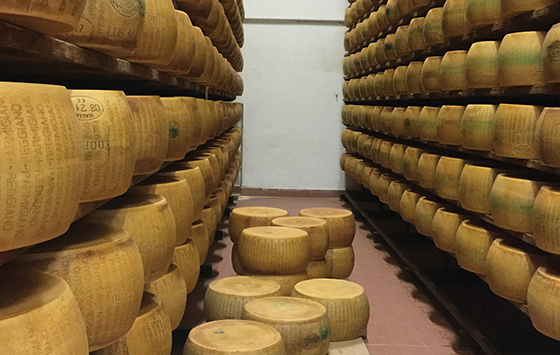What we may think of as mundane sandwich ingredients take on an entirely new meaning in Italy’s Po Valley.
by Mary Bailey
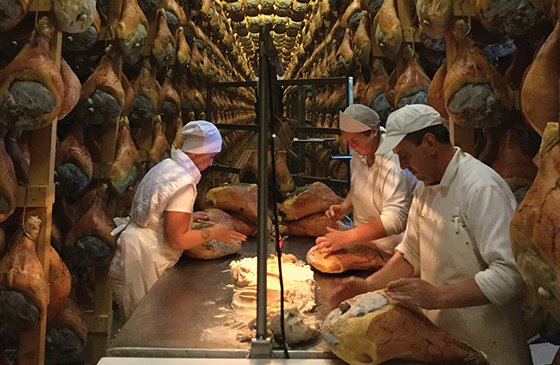
All photos Mary Bailey – click to zoom.
The Po Valley is not the Italy of cypress and olive trees. Rather, the landscape is pastoral, green fields and densely forested foothills rolling to the snow-capped peaks of the Alps. This landscape is home to two of the finest artisan foods in existence, Parmigiano Reggiano cheese and Prosciutto di Parma (ham of Parma). The making of each possess distinct preparation and aging requirements, which are monitored and regulated by both local and European authorities every step of the way.
Yet, what’s remarkable about Parma ham is how simple the process actually is— pork, sea salt, air and time, how people have cured ham for millennia.
At Pio Tosini, a fourth generation producer in Langhirano, Parma ham begins as large meaty legs with a significant fat cap to ensure even drying. A coating of sea salt is applied to pull moisture from the interior of the meat. After two months, the meat is washed to remove the salt then hung to dry again. When completely dry, the legs are hung in the aging room for up to 24 months, even longer in some houses. That’s pretty much it. The exposed part of the ham (without skin) is covered with a seasoning mixture (fat and spices) but other than that it’s a waiting game.
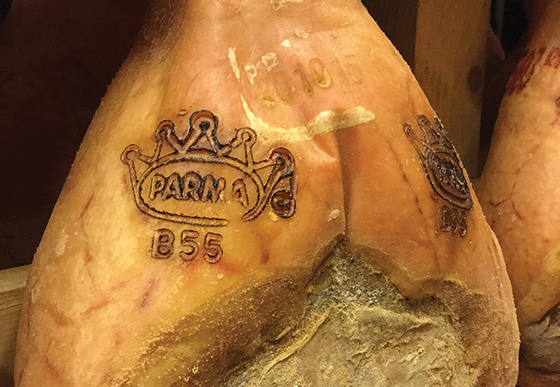
Pio Tosini is one of the few producers that continues the age-old practise of open-air aging. Every day the windows are opened in the morning to allow breezes from the sea to help age the hams. Their location, with its proximity to the sea, forest and mountains was the reason the first generation set up shop here.
It is quiet in the aging room, peaceful, like a library. It also smells amazing, sweet, salty, a bit nutty, fresh with a top note of herbs and forest.
Before the hams can wear the ducal crown, the stamp of authenticity in Parma, an inspector checks the ham for any hint of spoilage with the ago di osso di cavallo (horse bone needle). We watch as an aging room employee demonstrates. It’s a rapid dance, needle to nose then back again into the ham. She offers the needle. We smell… nothing. That is the key to horse bone, it captures and releases aroma in an instant. It’s also key to the training and expertise of everyone involved in the process.
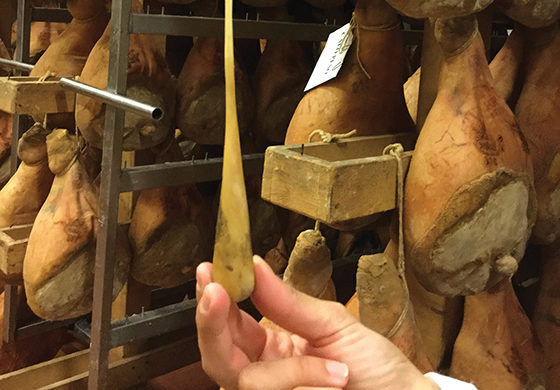
The finished crudo is delicious, velvety textured, a little salty, with an appealing sweet nuttiness. Proprietor Giovanni Bianchi serves it with a dry rosé Lambrusco—a sublime tasting experience.
Up until a few years ago, these high quality air-dried hams were not allowed in Canada. Whether this was due to food safety or to industry protectionism is a matter of debate, but now we are free to indulge.
Prosciutto di Parma and other air-dried hams (such as prosciutto di Modena or prosciutto di San Daniele) are known as crudo. Proscuitto cotto means cooked ham. The Italian Centre always has 14-month old prosciutto di Parma in the deli case. Ask for the 18- or 24-month old, also for culatello (made from the loin only, the heart of the proscuitto) and noce (butt) which are sometimes available.
Parma ham is a delicacy and expensive, so make sure you see the Parma crown before it’s sliced. Serve by itself or with other cured meats as a first course, ideally with its compatriot Lambrusco. The slight fizz and full-on grapey flavours (both dry and sweet, red or rosé) are an ideal foil for the sweet savouriness of Parma ham.
Melon in season with slices of Parma ham is delightful.
Daniel Costa asked the Italian Centre to bring in 18- and 24-month-old Ruliano Proscuitto, another Langhirano producer, for his restaurants Corso 32, Bar Bricco and Uccellino. “Ruliano is particular about the pigs, and I find the crudo tends to be sweeter and nuttier. We buy whole legs and also the culatello and noce.
Rosario Caputo of Cibo Bistro is experimenting with making his own air-dried ham. “We made our first over a year ago with a Berkshire leg from Irving’s. My dad has a space in Jasper where he makes wine; it’s the perfect temperature with proper humidity. We cured the leg with salt, pepper, garlic, curing salt (nitrate) fresh herbs and garlic, then rubbed it every five days with red wine. We hung it for 400 days. We are going to try Mangalista next time, it has a bigger fat cap.”
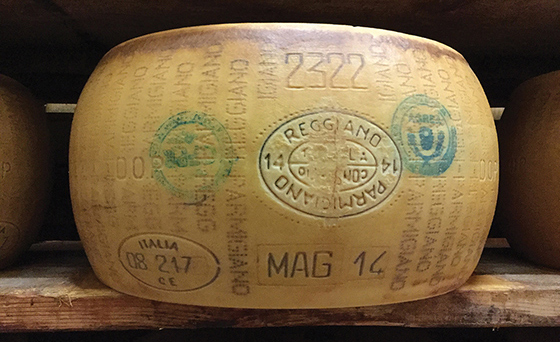
guaranteed by these markings.
Parmigiano Reggiano is a cow’s milk made in a specific area around Parma. Many of the dairies are co-ops bringing in milk from several small farms. I’ve been in Parmigiano dairies that make eight wheels a day and others that make 24, considered an average size dairy. It takes approximately 500 litres of milk to make two wheels of Parmigiana and their byproducts, whey and butter.

This May I visited another dairy (courtesy of the Italian Trade Commission) to learn more about the process. The cheese is made daily, first heated, but not pasteurized, to develop the curd. After a period of time, when judged ready by the cheese maker (shown above), it’s put into the characteristic round form (below). At two days old the cheese is 55ºC inside. Each round is identified by dairy, batch, and date of production. Once the cheese has settled it’s taken out of the from and put into the aging room with controlled humidity and temperature. It’s not constant. The makers want the cheese to feel the seasons, according to our guide Simone Ficarelli.
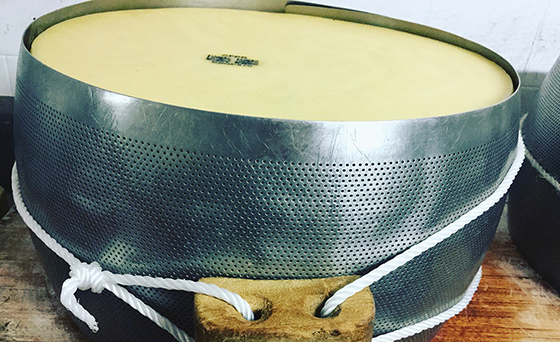
Each round is assessed when it is 12 months old. If not deemed suitable to become Parmigiano Reggiano, the rounds are taken out of the aging room and sold off as grated or chunked grana (hard cheese). It cannot be called Parmigiano. The ones that do show the characteristics of Parmigiano Parmigiano are sold at 12 months, or aged to 24, 30 or 36 months.
At 12 months old the cheese has a milky flavour (there is actually no lactic acid present; this disappears within 72 hours during the cheese making process). It is not granular, rather, it’s quite chewy. Simone suggests Lambrusco or Prosecco as the ideal pairing for 12-month-old Parmigiano. At 24 months the cheese is nuttier, a bit sharper, more savoury, more granular in texture, yet melts on the tongue. At 36 months it’s darker-coloured, mellow in flavour, noticeably salty and much more granular with crunchy crystals. Simone prefers beer with 36-month-old Parmigiano.
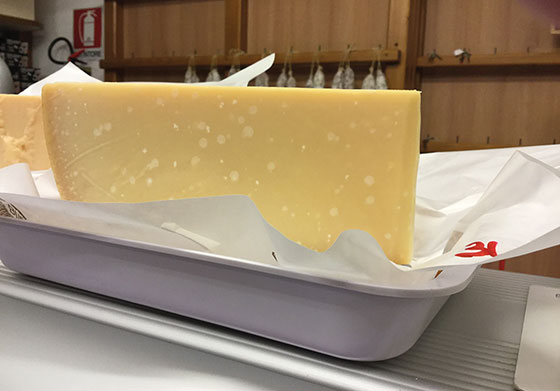
In the Parma area you will find small-production cheeses, identified by producer, age, the dairy and type of cow, on menus even in the smallest and the most casual of restaurants. Unfortunately, due to the cheese quota system, few of these cheeses come to Canada. The Italian Centre’s standard is 24 months, they are able to bring in 36-month occasionally when they can get it. Right now there is a shortage of Parmigiano according to Ralph Stabile, director of purchasing at the Italian Centre. For example they are unable to find Vaca Rosso Parmigiano, preferred by several chefs.
Older is not necessarily better; it really is a matter of personal taste and how you plan to use it. In risotto or grated over pasta? On a cheese board? Parmigiano is very high in glutamate (umami) and a little goes a long way. Serve chunks of older Parmigiano with dried fruit and walnuts and Amarone, a glass of Fino Sherry or a sweet dessert wine such as Vin Santo. I also love it with Champagne or Franciacorta. Let the cheese warm to room temperature before serving.
